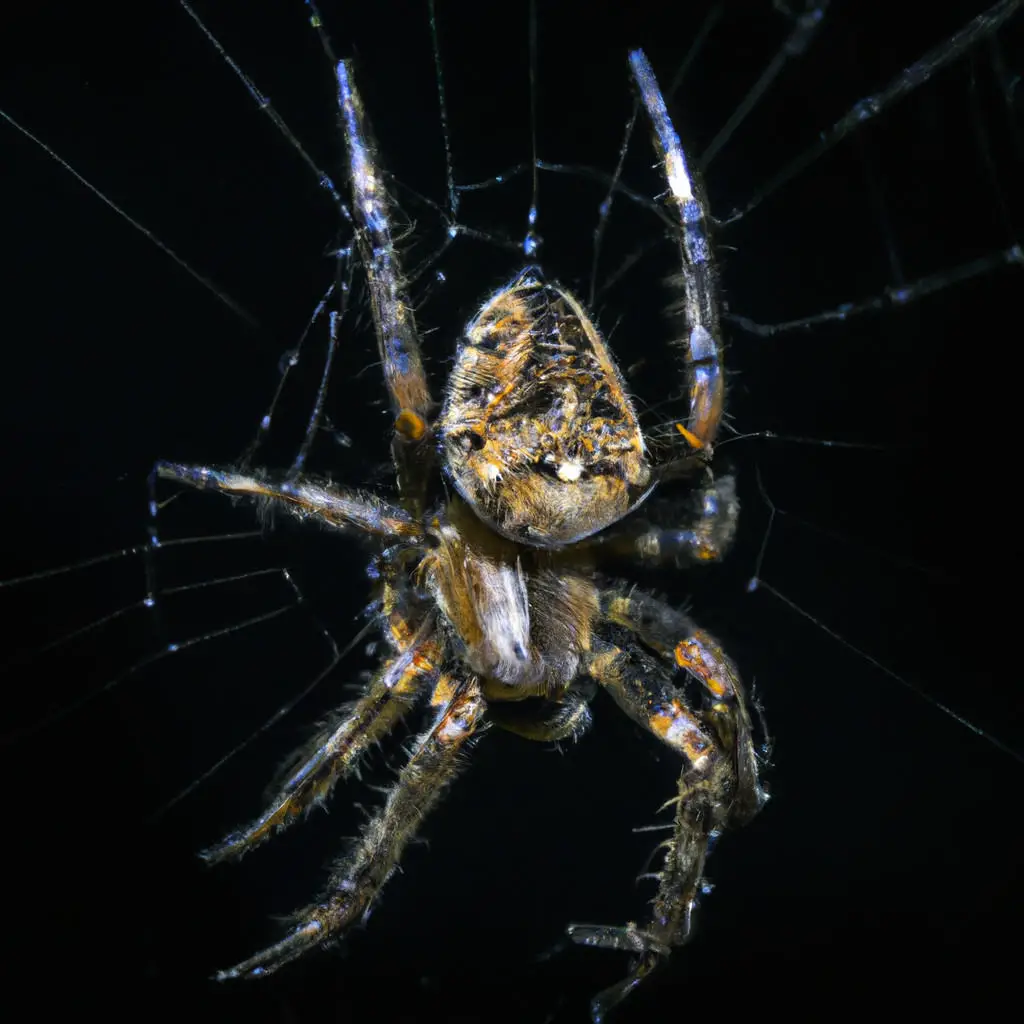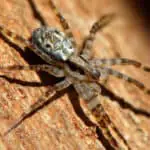As someone who has encountered a spider in their home or garden, it’s natural to wonder whether the spider is pregnant. Identifying a pregnant spider can help you understand its behavior and life cycle, which can be especially important if you’re interested in spider conservation. In this article, I will provide you with tips on how to identify a pregnant spider, including physical and behavioral cues to look out for.
Understanding spider reproduction is crucial to identifying a pregnant spider. Spiders reproduce by laying eggs, and female spiders typically produce an egg sac to store their eggs. As the spider carries the eggs, its abdomen will become enlarged, which is one of the most obvious signs of pregnancy. However, other factors such as hormonal changes can also indicate that a spider is pregnant. By observing spider behavior and reproduction, we can increase our knowledge of these fascinating creatures and aid in conservation efforts.
Key Takeaways
- Understanding spider reproduction is crucial to identifying a pregnant spider
- Physical and behavioral cues can help identify if a spider is pregnant
- Identifying a pregnant spider can aid in conservation efforts and increase our knowledge of these fascinating creatures.

Understanding Spider Reproduction
Spiders are fascinating creatures with a unique reproductive process. In this section, I will explain the mating process and egg laying and development in spiders.
Mating Process
The mating process in spiders is quite different from that of other animals. Male spiders use their reproductive openings, called pedipalps, to transfer sperm to the female spiders. During courtship, the male spider will spin a special web called a sperm web to deposit his sperm. The female spider will then take the sperm into her body and store it until she is ready to lay eggs.
Egg Laying and Development
Female spiders will lay their eggs in an egg sac, which they will then guard until the spiderlings hatch. The egg sac can vary in size and shape depending on the species of spider. Once the spiderlings hatch, they will emerge from the egg sac and begin their lives as independent spiders.
It is important to note that not all female spiders will lay eggs. Some species of spiders are parthenogenic, which means they can reproduce without fertilization from a male spider. In these cases, the female spider will lay eggs that are genetically identical to herself.
Understanding spider reproduction is essential for conservation efforts and increasing our knowledge of these fascinating creatures. By observing spider reproduction, we can gain valuable insights into their life cycle and behaviors.
Identifying a Pregnant Spider
As a spider enthusiast, I know that identifying a pregnant spider can be a fascinating experience. However, it can also be challenging, especially if you don’t know what to look for. In this section, I will highlight some of the physical and behavioral changes that you can use to identify a pregnant spider.
Physical Changes
One of the most obvious physical changes in a pregnant spider is an enlarged abdomen. The female spider’s abdomen will become larger as she carries her eggs. Pregnant spiders will exhibit noticeable abdominal swelling as they fill up with eggs. This swelling is typically more obvious in spiders that can be kept as pets or observed in the wild, such as tarantulas. The abdomen of a pregnant spider may become round and noticeably larger than its non-pregnant counterparts.
When pregnant, spiders produce an egg sac, which holds many eggs. Egg sacs are smooth and round, attached to the spider’s web. Many species of spiders have the same symptoms when carrying eggs, it’s usually the size of the spider’s abdomen by which you can tell if a spider is pregnant.
Behavioral Changes
In addition to physical changes, pregnant spiders may also exhibit behavioral changes. For example, some spiders may become more aggressive or defensive when they are pregnant. This is because they are protecting their eggs and want to ensure that they hatch successfully.
Furthermore, pregnant spiders may also emit sounds or pheromones to attract mates or repel predators. These sounds and pheromones can be detected using specialized equipment, but they are often difficult to hear or smell with the human senses alone.
In conclusion, identifying a pregnant spider requires careful observation of physical and behavioral changes. By watching for an enlarged abdomen, egg sacs, changes in behavior, and other signs, you can determine if a spider is gravid. However, it is important to note that not all species of spiders exhibit the same symptoms when carrying eggs, so it is essential to research the specific species you are interested in.
Different Spider Species and Pregnancy
As mentioned earlier, different species of spiders may exhibit different symptoms when they are pregnant. In this section, we will take a closer look at some of the most common spider species and how to identify if they are pregnant.
Common House Spiders
Common house spiders are one of the most prevalent spider species in the world. They are usually brown or gray and have a small body size. When pregnant, female house spiders may develop a slightly larger abdomen, but it is not always noticeable. They typically produce small egg sacs that contain around 100 eggs.
Jumping Spiders
Jumping spiders are known for their agility and unique eye pattern. When pregnant, female jumping spiders develop a larger abdomen that is more noticeable than in other spider species. They typically produce a single egg sac that contains around 50 eggs.
Wolf Spiders
Wolf spiders are large and hairy with a distinctive eye pattern. When pregnant, female wolf spiders develop a larger abdomen that is more noticeable than in other spider species. They typically produce a single egg sac that contains around 100 eggs.
Black Widow Spiders
Black widow spiders are one of the most venomous spider species in the world. When pregnant, female black widow spiders develop a larger abdomen that is more noticeable than in other spider species. They typically produce a single egg sac that contains around 300 eggs.
Brown Recluse Spiders
Brown recluse spiders are known for their venomous bite and distinctive violin-shaped marking on their body. When pregnant, female brown recluse spiders develop a larger abdomen that is more noticeable than in other spider species. They typically produce a single egg sac that contains around 50 eggs.
Huntsman Spiders
Huntsman spiders are large and flat with long legs. When pregnant, female huntsman spiders develop a larger abdomen that is more noticeable than in other spider species. They typically produce a single egg sac that contains around 200 eggs.
Tarantulas
Tarantulas are large and hairy with a distinctive appearance. When pregnant, female tarantulas develop a larger abdomen that is more noticeable than in other spider species. They typically produce a single egg sac that contains around 500 eggs.
In conclusion, identifying if a spider is pregnant can be challenging, but it is possible by observing the size of their abdomen and the characteristics of their egg sacs. Different spider species may exhibit different symptoms when they are pregnant, so it is important to know the unique characteristics of each species.
What Happens Post Pregnancy
After a spider gives birth, what happens next? In this section, we’ll explore what occurs post-pregnancy for both baby spiders and the mother spider.
Baby Spiders
Once the spiderlings hatch, they will remain in the egg sac for a period of time. During this time, they will feed on the remaining yolk sac within the egg sac. After the yolk sac is depleted, the spiderlings will emerge from the egg sac and disperse.
Spiderlings are vulnerable to predators and environmental factors, such as temperature and humidity. As a result, the mortality rate for spiderlings is high. However, those that survive will continue to grow and molt until they reach maturity.
Mother Spider’s Fate
After giving birth, the mother spider’s fate is not always certain. In some cases, the mother spider will continue to care for her spiderlings for a period of time before dying. In other cases, the mother spider may abandon her spiderlings or even eat them.
It is important to note that killing a pregnant spider is not recommended. Not only is it cruel, but it can also harm the ecosystem by disrupting the natural balance of predator and prey. Instead, it is best to simply relocate the spider to an area where it will not be a nuisance.
In conclusion, post-pregnancy for spiders is a critical time for both the mother spider and her spiderlings. While the survival rate for spiderlings is low, those that do survive will continue to grow and molt until they reach maturity. As for the mother spider, her fate is not always certain, but it is important to avoid harming her or her offspring.
Visual Identification Guide
So, you want to know if a spider is pregnant? Here’s what you need to look for:
- Enlarged abdomen: A pregnant spider will have a noticeably larger and rounder abdomen than non-pregnant spiders. The swelling is due to the spider filling up with eggs. You can easily spot this by observing the spider’s body shape.
- Egg sacs: When spiders become pregnant, they produce an egg sac, which holds many eggs. Egg sacs are smooth and round, attached to the spider’s web. Many species of spiders have the same symptoms when carrying eggs, it’s usually the size of the spider’s abdomen by which you can tell if a spider is pregnant.
- Behavioral changes: Some species of spiders may exhibit changes in their coloration and behavior during pregnancy. For example, some spiders become more aggressive or may stop eating altogether.
- Expert identification: If you’re still unsure, experts may be able to identify a female spider’s eggs by inspecting the spider’s reproductive organs. However, this requires specialized knowledge and equipment, so it’s best to leave it to the professionals.
When it comes to visual identification, it’s important to keep in mind that not all spiders look the same. Different species have different body shapes, colors, and behaviors. If you’re having trouble identifying a spider, consider taking a photo or video and submitting an ID request to a spider identification community or expert.
Remember, it’s always best to observe spiders from a safe distance and avoid handling them. If you’re unsure about the safety of a spider, it’s best to leave it alone.
Conclusion
In conclusion, determining whether a spider is pregnant can be challenging, but there are a few indicators that can help. Observing the spider’s behavior and size are the two main indicators. Pregnant spiders tend to be larger and more sluggish than non-pregnant spiders. The abdomen of the female spider will also become extended when pregnant, but it’s important to note that sometimes the abdomen might get bigger from the food.
Different species of spiders have different physical cues that indicate pregnancy. For example, pregnant black widow spiders have a round, swollen abdomen that is more prominent than their non-pregnant counterparts. On the other hand, the egg sac of black widows will come out between one and four weeks, indicating that they are pregnant. Similarly, house spiders have a different physical appearance when pregnant, with a larger and more rounded abdomen.
Ultrasound is another option to determine if a spider is pregnant, but it is not always necessary. If you are unsure about whether a spider is pregnant, it’s best to take it to a vet to ensure its health throughout the pregnancy.
In summary, observing the spider’s behavior and size, looking for physical cues, and taking it to a vet if necessary are the best ways to determine if a spider is pregnant. Remember to handle spiders with care, as they are delicate creatures that play an important role in our ecosystem.
Frequently Asked Questions
How to determine if a spider is pregnant
To determine if a spider is pregnant, you can look for physical and behavioral cues. Pregnant spiders will exhibit noticeable abdominal swelling as they fill up with eggs. This swelling is typically more obvious in spiders that can be kept as pets or observed in the wild, such as tarantulas. You can also look for an egg sac, which holds many eggs and is smooth and round, attached to the spider’s web.
What do pregnant spiders look like
Pregnant spiders will have a noticeably larger abdomen than their non-pregnant counterparts. The abdomen may become round and swollen as it fills up with eggs. However, the appearance of a pregnant spider can vary depending on the species.
How long are spiders pregnant for
The length of a spider’s pregnancy can vary depending on the species. Some spiders can be pregnant for a few weeks, while others can carry their eggs for several months.
How do spiders get pregnant
Spiders reproduce through sexual reproduction. Male spiders deposit sperm into a female spider’s reproductive system, which fertilizes the eggs. The female spider then produces an egg sac, which holds many eggs.
What to do if you encounter a pregnant spider
If you encounter a pregnant spider, it is best to leave it alone. Spiders are an important part of the ecosystem and play a vital role in controlling insect populations. If you are concerned about the spider’s presence, you can contact a local pest control professional for advice on how to safely remove it.
Can you kill a pregnant spider
It is not recommended to kill a pregnant spider. Spiders are an important part of the ecosystem and play a vital role in controlling insect populations. Killing a pregnant spider can also result in the death of its offspring, which can have negative effects on the local ecosystem. If you are concerned about the spider’s presence, you can contact a local pest control professional for advice on how to safely remove it.








